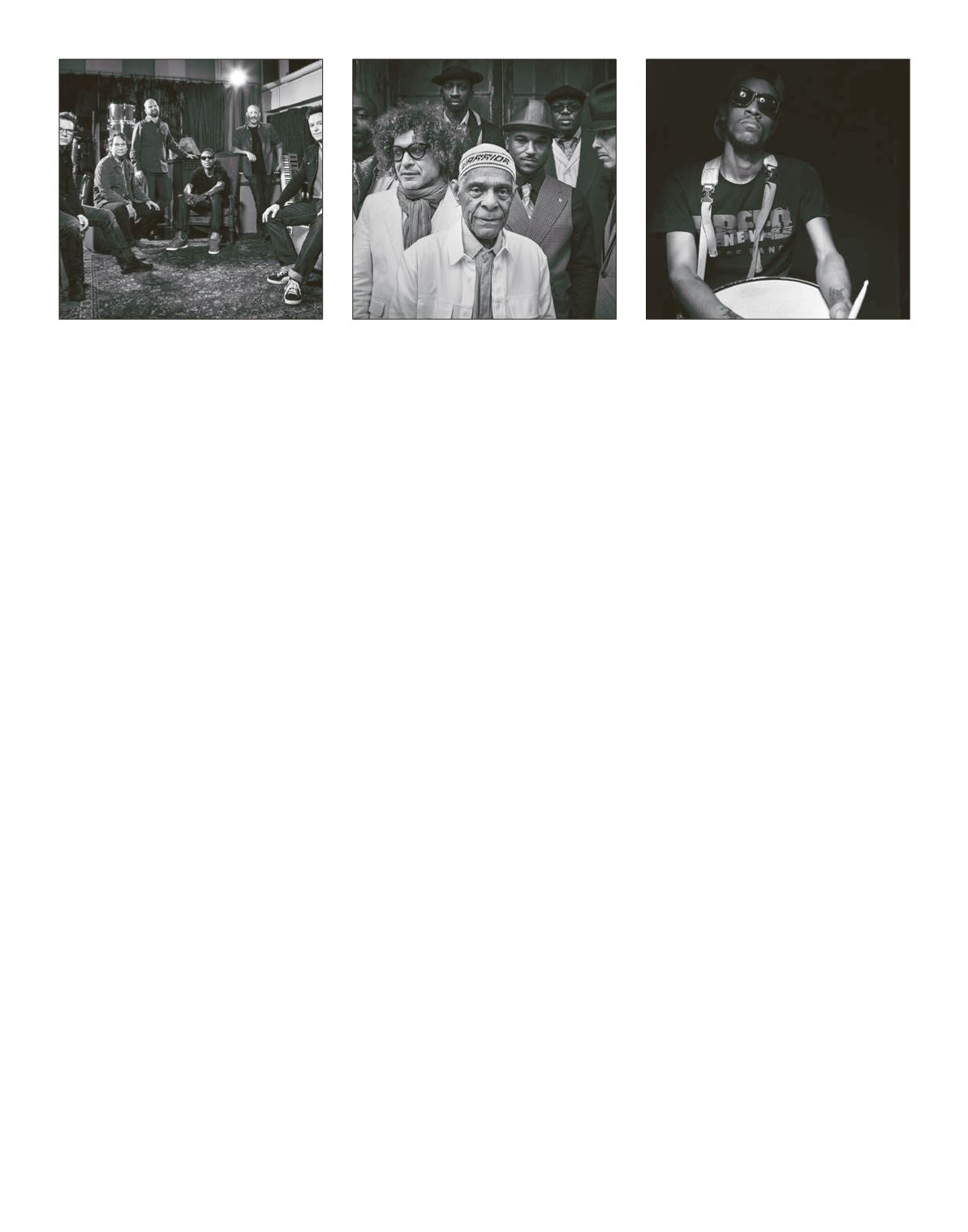
GALACTIC
e jazz-funk ensemble Galactic formed in New
Orleans in
with saxophonist Ben Ellman,
guitarist Je Raines, organist Rich Vogel, bassist
Robert Mercurio, and drummer Stanton Moore,
quickly attracting a fervent following behind
a nonstop live schedule. Within two years, the
group had created its debut record,
Coolin’ O
,
which received a wider release when the sextet
was scooped up by Capricorn label to follow
up with
Crazyhorse Mongoose
in
. A er the
millennium turned, Galactic turned out the
Bill-
board
contemporary jazz number-four hit
Late
for the Future
, followed by a live disc,
We Love
’em Tonight
(
), which was captured at Tipiti-
na’s in New Orleans.
Ruckus
(
) marked the
last time a vocalist appeared with the group as an
o cial member of the band. However, for
’s
From the Corner to the Block
, the group’s debut
on the Anti- label, Galactic invited a host of hip-
hop musicians and MCs to guest on almost ev-
ery track; a few fellow New Orleans musicians
entered the mix too, including Trombone Shorty
on “Tu Love.” A similar formula was followed
on
’s
Ya-Ka-May
, but instead
all
the guest
musicians were from the post-Katrina New Or-
leans stock, from Allen Toussaint and the Re-
birth Brass Band to Irma
omas and Walter
“Wolfman” Washington—even the album title
was steeped in the Crescent City, borrowing the
name of an Afro-Orleanian soup made from
anything at hand. For its next disc,
Carnivale
Electricos
(
), Galactic looked to the south,
exploring connections between Mardi Gras
and Brazil’s Carnival.
e group’s last album
with Anti-, it again tapped into a wide-ranging
supporting cast, from Cyril and Ivan Neville to
rappers Mystikal and Mannie Fresh, in addition
to incorporating Brazilian samba rhythms and
other musical signatures. Continuing its cross-
over with R&B, Galactic enlisted the voices of
Macy Gray, Mavis Staples, Ryan Montbleau, and
more on its latest album,
Into the Deep
( ). A
new single, “Hold On to Let Go,” was released
earlier this year to tease the group’s upcoming
ninth studio release. Galactic is making its Ra-
vinia debut.
PRESERVATION HALL JAZZ BAND
By the late
s, New Orleans had become a
hub for the top traditional jazz musicians of the
day, but the city lacked a agship venue to bring
them together. Enter the art gallery Preservation
Hall and the young tuba player who was hired
to manage the space in
, Allan Ja e. With
such popular gures as pianist Sweet Emma
Barrett, clarinetist George Lewis, trumpeter Kid
omas Valentine, trombonist Jim Robinson,
brothers clarinetist Willie and trumpeter Percy
Humphrey, and husband and wife trumpeter
Billie and pianist De De Pierce, the Preservation
Hall Jazz Band, as the regular house ensemble
became known, was quickly enshrined as not
only a staple of the bustling New Orleans live
music scene but also a top-notch touring band.
Over its rst decade and a half, the Preserva-
tion Hall Jazz Band primarily devoted its time
to these live performances, but Barrett and the
Pierces each headed up a recording with the
group during its rst ve years, in
and
, respectively, as independent releases un-
der a Preservation Hall house label. In the late
’ s, with the retirement of Barrett and the re-
placement of Robinson with Frank Demond as
primary trombonist, the group began recording
a series of albums featuring New Orleans jazz
staples with Columbia, ultimately releasing four
volumes of
New Orleans
between
and
,
with the third installment also taking on the title
of its centerpiece, “When the Saints Go Marchin’
In.” Ja e’s son, Ben, became Preservation Hall’s
creative director in the early ’ s, and the band
not only renewed but increased its commitment
to recording, especially as its sound began to
re ect not only traditional New Orleans jazz
but also the diversity of sounds that had taken
root in the city since the band’s founding—from
gospel and R&B to various roots traditions. In
, the Preservation Hall Jazz Band accepted
the National Medal of the Arts.
at’s It!
( )
was the band’s rst album of entirely original
material in its -year history, followed in
by
So It Is
. e Preservation Hall Jazz Band rst
played Ravinia in
and tonight makes its
th appearance at the festival.
NEW BREED BRASS BAND
e New Breed Brass Band was founded by ve
New Orleans natives to live and breathe the cul-
ture of the city, fusing funk, rock, hip-hop, and
jazz into a unique evolution of the second-line
brass band tradition. Having grown up with the
second lines of the Rebirth, Dirty Dozen, and
Li’l Rascals Brass Bands, the New Breed mem-
bers have also counted artists like Earth, Wind
& Fire and Brass Construction as in uences in
creating their own musical identity.
e New
Breed Brass Band made its street debut with
four new members in
at the Nine Times
Second Line and also took part in the Red Bull
Street Kings brass band competition that year.
e group has since opened concerts for such
artists as
e Fray, Red Baraat, Dr. John,
e
Waterboys, and Trombone Shorty & Orleans
Avenue. With family members including such
New Orleans legends as James “ ” Andrews,
Troy “Trombone Shorty” Andrews, Topsy
Chapman, Karl Leblanc, and Bruce “Sun-pie”
Barnes, most of the New Breed members have
been steeped in music since they were toddlers,
playing with their families and on through high
school marching bands and concert ensembles.
e band’s strong desire is to be the next heavy-
weight contender among internationally known
New Orleans brass bands. e New Breed Brass
Band is making its Ravinia debut.
AUGUST 20 – AUGUST 26, 2018 | RAVINIA MAGAZINE
127








